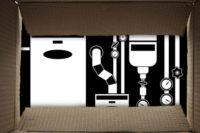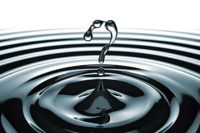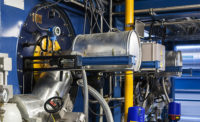Designing a commercial boiler replacement where you were not the original designer or installer might have some hidden dangers that could haunt you for years. The project is going to be a series of assumptions, educated guesses, design skills, and some good old-fashioned luck. The boiler is only part of the heating system, albeit an integral part. Always assume that the existing boiler is installed incorrectly.
When designing a replacement low pressure steam boiler, it should be sized according to the existing connected load. The connected load includes all piping, radiators, and heat emitters. Unlike the steam boiler replacement, a replacement hydronic boiler system will be sized according to the building heat loss.
Have you ever found yourself in the middle of an internal power struggle? That is exactly what happened to me on this project. The director of maintenance for a university called and wanted to use my boilers for a building that had a leaking old cast iron boiler. Unknown to the director of maintenance, the finance director hired an architect/engineer firm to design the new heating system. Obviously, they do not communicate well. I called the engineer and asked to see him about the project.
“I am familiar with your boiler and we want the most efficient boiler we can get for this project. Your boiler will not work for this project,” the engineer informed me.
“I have both standard efficiency boilers as well as condensing boilers,” I replied
“These boilers are 99% efficient and yours are only 96% efficient. Every little bit counts,” he answered in a most condescending way.
When I looked at his design, I shook my head and said with respect, “You will be lucky to get about 85% efficiency from the system. You are using the condensing boiler to provide space heat, heat the pool, and the domestic hot water.”
It went downhill after that. The engineer pointed his finger at the boiler brochure and said “See, it says 99% efficient. We are done.” And with that I was out of the office. I stopped by the director of maintenance office to explain what happened. I showed the director of maintenance the boiler efficiency charts and pointed to the graph that shows that the boiler will indeed reach 99% efficient if the return water is below 70°F and the burner firing rate is at low fire. In my area, 70 degree water inside a cast iron radiator usually does not raise the room temperature from 68° to 70°F. The engineer used my competitor’s condensing boiler for the project.
What are you connecting to?
If you are replacing a furnace in a home with a new one, a condensing furnace make sense, as that unit will condense any time that it is operating due to the temperature difference between the room air and flue gas temperature. When you are connecting a condensing boiler to an existing hydronic system, it may or may not condense. A good rule of thumb is that a condensing boiler will only condense when the boiler water temperature is below 140°F. If the system is operating above that temperature, the condensing boiler will see efficiencies in the mid 80% range. Most boilers will not reach 90% efficient until the boiler water temperature is below 120°F. The majority of the older hydronic systems were designed to provide 180 degree water at the outdoor design temperature in the locale.
On this project, the designer used a water to water heat exchanger to heat the domestic water. The system used the hot water inside the boiler to heat the water from outside up to the desired discharge temperature. For commercial buildings with a kitchen, the discharge hot water temperature to the building should be around 140°F. Many facilities are using this temperature now to kill the Legionella inside the pipes. To raise the incoming water temperature from the ground temperature to 140°F, the boiler water has to be higher than 140°F. It may be 20°F higher than the domestic water temperature. If that is the case, the boiler water temperature will be at 160°F and the boiler efficiency will be around 84-86% efficient.
The pool heat exchanger will also require a warmer temperature than the discharge temperature to the pool. Assuming that we have a 110°F discharge temperature, our boiler water must be higher than that and it may be 10 to 20 degrees higher. The difference in efficiency is wide at that temperature. At 120°F, the boiler efficiency will be around 91% and the efficiency drops to 86% at 130°F.
Condensing or noncondensing
I believe condensing boilers are a great heating system when used within their design parameters and think that operating condensing boilers at 180 degree water is wasteful. It is like using a race car to do stop-and-go driving. Hybrid heating systems, consisting of one or more standard efficiency boilers paired with one or more condensing boilers, offer a cost-effective strategy. My controls will make the standard efficiency boilers as the lead boilers when the supply water temperature is above 140 degrees. They become the lag boilers if the supply water temperature is below 140°F. In that way, I get the efficiency of a condensing boiler with the longevity of a standard efficiency boiler. In addition, my installed costs are much lower. It is a win-win for the customer. If you want to use condensing boilers that will always condense, you will have to see whether the existing heat emitters are large enough to heat the space using the lower temperatures. If not, extra heating surface installation is required, and perhaps larger pipes as well. This may be fiscally unrealistic since the piping size may also need to be increased.
What about combustion air?
Most new high-efficiency boilers require direct venting of the combustion air from the outside. If the boiler room has an air conditioner in it, the International Mechanical Code requires either a refrigerant monitoring system or direct piping of the combustion air from the outside to the burner for the fuel burning appliances in the boiler room. This includes the water heater as well.
Caution should be used in using direct connected combustion air as the fuel to air ratio of the burner changes when the outdoor temperature or barometric conditions change. For example, if the boiler had the fuel to air ratio set when the outside air temperature was at 80°F, the burner would have 50% more excess air when the temperature dropped by 20 degrees to 60°F due to the density change of the air. If the combustion air temperature dropped to 40°F, the burner would have 66% more air, dropping the efficiency of the boiler. A more dangerous condition to consider is if the fuel-to-air was adjusted when the outdoor air temperature was low.
When the air temperature rises, the air is less dense and the oxygen content is lower. The burner could actually soot due to the low oxygen content of the combustion air. Slight barometric changes can also affect the fuel to air ratio of burners. If the barometric pressure changes from 29 to 28, the excess air will drop by 33%. If the boiler uses combustion air directly connected to the outside, the fuel-to-air ratio should be checked at least twice per year.
The International Fuel Gas Code calls for two openings inside a boiler room for combustion air. One opening shall be within 12 in of the ceiling and one within 12 in of the floor. They shall be sized for 1 in of free space for each 4,000 Btuh of fuel burning appliances. Free area is typically sized at 75% for metal louvers and 50% for wooden outdoor louvers.
Venting
Many of the newer boilers will require a change in the venting of the boiler. The new boilers may require PVC, CPVC, Polypropylene, or stainless steel. New venting will increase the project cost. Caution should be used when venting the new boilers, as the flue temperatures may be beyond the temperature limits of the venting material. If the heating system requires 180 degree water at the outdoor design temperature, this may exclude PVC from the venting material as it is only rated for 140 degrees. The following is a temperature rating of different venting material.
Distribution
When changing a heating system, I like to change the pump as well. According to ASHRAE, the life expectancy of a pump is about ten years. By changing the pump, you are assured that the pump is properly sized for the new boilers. In addition to properly sized pumps, there are some new technologies that really can drive the operating costs down for a pump. Electronically Commutated Motors (ECM) are really efficient ways to transport the water throughout the building. To see how efficient of a transportation mode they are, consider this: A fan requires 10 times the amount of energy to transport the same amount of Btus as an ECM pump.
Piping
According to the 2012 International Energy Code, boiler plants including more than one boiler shall have the capability to reduce flow automatically through the boiler plant when a boiler is shut down. If your locale adheres to this code, that means that you will have to pipe the boilers using primary secondary piping or use an isolation valve for each boiler. Primary secondary piping is the traditional way to pipe boilers but we still see isolation valves used. There are several concerns to consider when using the isolation valves. The first is that if the valve is closed and flow is stopped right after the burner stopped firing, the boiler temperature will continue to climb and could trip the manual reset limit control. This will lead to a “No heat” call on the next call for heat. The other consideration is excessive flow. If one boiler is shut off, all the flow may go through the operating boiler and it may be excessive.
If using primary secondary piping, the takeoffs to the boiler should be within 12 in of each other. If they are further apart, you could have ghost flow throw the idle boilers, increasing your operating costs and boiler off-time losses.
Pipe insulation
According to the 2012 International Energy Conservation Code, all piping serving as part of a heating or cooling system shall be thermally insulated in accordance with Table C403.2.8. The following is list of insulation thicknesses as recommended by the code:
Expansion tanks
One of the common things we see on a replacement boiler project is to reuse the existing expansion tanks. When water is heated, it will expand at 3% of its volume. That expansion of the water has to be managed and is typically done by expansion tanks. When reusing the existing tanks, the sizing should be verified. The tanks should be inspected to see if any leaks are in the tank. Look at the top of the tank for pin holes as this will allow the tank to flood. A way to test if the expansion tank is flooded or the piping is plugged to the tank is to watch the boiler pressure gauge as the boiler fires. If the pressure climbs when the burner fires, this usually means that the tank is flooded or the piping to the tank is plugged.
If you are reusing the tank, I have several suggestions. The first is to replace the gauge glass fittings on the tank. The packing on the top valve dries out and will allow the air to leak out, resulting in a flooded tank. The Airtrol fitting should also be replaced, since the tube sometimes breaks. I would also suggest new piping from the hydronic loop to the tanks. It has a tendency to plug and cause the relief valve to open or weep. A backflow preventer should be installed on the feed water pipe to the boiler.
You do not want the boiler water to be able to mix into the buildings potable water supply. A health care facility in this area had the boiler water connected to the potable water on a new addition. It was never detected until the facilities manager changed water treatment companies and the new water treatment specialist recommended a dye in their chemicals to show if it was leaking. Shortly afterward, a nurse filled a white Styrofoam cup with water and noticed a pink hue to the water. She called the maintenance department and they found the cross connection. It was an ugly scene and lawyers were everywhere.
The water feeder should be replaced at the same time. An old water feeder could be the weak link in the system. One pound of pressure will raise water 2.3 ft. A good rule of thumb is that the boiler pressure should be half the height of the tallest radiator. If the tallest radiator is 50 ft high, the system fill pressure should be 25 pounds.
Water treatment
The new boiler will require water treatment. A specialist should be consulted, and the construction of the new boiler should be considered as well as the system piping. If the new boiler is cast aluminum, the water treatment will be different than if it is stainless steel or copper.
Good luck when marrying the new equipment with the existing.










